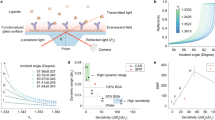Abstract
A surface-sensitive fluorescence measurement platform is utilised in the detection of morphine. The platform is based on a polystyrene parabolic lens that enables the simultaneous application of total internal reflection excitation and supercritical angle fluorescence detection in the measurements. The molecular recognition of morphine is based on two antibodies, one against morphine and the other against the immune complex formed between the anti-morphine antibody and a morphine molecule. The antibodies are applied in a sandwich-like format in a one-step test, where the molecular binding onto a liquid-solid-interface is monitored in real time. Morphine concentrations between 0.6 and 18.2 ng/mL were reliably determined in 60 s, while concentrations down to 2.7 ng/mL were detected already in 20 s. With appropriate recognition molecules the technique is applicable also to other drugs and small analytes.






Similar content being viewed by others
References
Kerrigan S, Phillips WH (2001) Comparison of ELISAs for drugs-of-abuse testing. Jn Clin Chem 47:540–547
Pulli T, Höyhtyä M, Söderlund H, Takkinen K (2005) One-step homogeneous immunoassay for small analytes. Anal Chem 77:2637–2642
Dams R, Choo RE, Lambert WE, Jones H, Huestis MA (2007) Oral fluid as an alternative matrix to monitor opiate and cocaine use in substance-abuse treatment patients. Drug Alcohol Depend 87:258–267
Välimäki H, Tappura K (2009) A novel platform for highly surface-sensitive fluorescent measurements applying simultaneous total internal reflection excitation and super critical angle detection. Chem Phys Lett 473:358–362
Ruckstuhl T, Rankl M, Seeger S (2003) Highly sensitive biosensing using a supercritical angle fluorescence (SAF) instrument. Biosens Bioelectron 18:1193–1199
Enderlein J, Ruckstuhl T, Seeger S (1999) Highly efficient optical detection of surface-generated fluorescence. Appl Opt 38:724–732
Lakowicz JR (1999) Principles of fluorescence spectroscopy, 2nd edn. Kluwer Academic/Plenum Publishers, New York
O’Shannessy DJ, Brigham-Burke M, Soneson K, Hensley P, Brooks I (1993) Determination of rate equilibrium binding constants for macromolecular interactions using surface plasmon resonance: use of nonlinear least squares analysis Methods. Biochem Anal 212:457–468
Vikholm-Lundin I (2005) Immunosensing based on site-directed immobilization of antibody fragments and polymers that reduce nonspecific binding. Langmuir 21:6473–6477
Acknowledgements
We thank Armi Boman for skilful technical assistance, Dr. Tarja Nevanen for commenting on the manuscript, and TEKES, the Finnish Funding Agency for Technology and Innovation, for financial support (40240/07).
Author information
Authors and Affiliations
Corresponding author
Rights and permissions
About this article
Cite this article
Välimäki, H.S., Pulli, T. & Tappura, K. Applying Total Internal Reflection Excitation and Super Critical Angle Fluorescence Detection to a Morphine Assay. J Fluoresc 20, 1003–1008 (2010). https://doi.org/10.1007/s10895-010-0647-8
Received:
Accepted:
Published:
Issue Date:
DOI: https://doi.org/10.1007/s10895-010-0647-8




